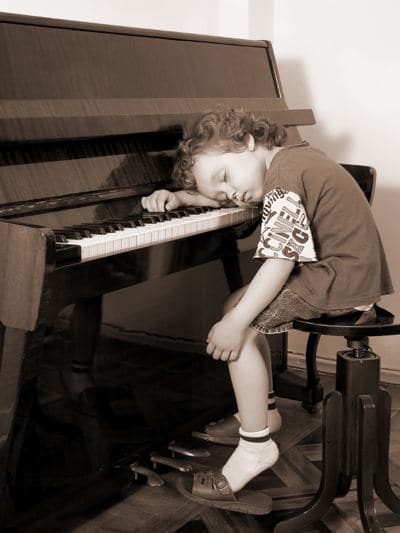Music Lessons: Get Your Child to Practice With Gamification
As we all know, with the holidays comes free time (maybe not for you, but definitely for your children). Wouldn't it be great if your budding little musicians used some of that time to do a little practicing? It's picturesque thought -- the pleasant sounds of your child earnestly working out the last few measures of "Silent Night" on the piano while you relax in the living room with a cup of egg nog. Doesn't that sound nice? Not just the egg nog, but the warm bliss of knowing that what your child is doing has hugely positive ramifications for personal fulfillment, self-discipline and lifetime success. But, of course, here's the problem: self-motivated discipline doesn't exactly come naturally to young kids. Therefore, it's up to you to help create positive, engaging and fun ways to practice as a path towards self-motivation. It's time to put down that egg nog and get in that practice room. You're going to do a little "gamification."
To "gamify" something is to add the mechanics of games (with all their built in incentives and rewards) to non-game activities. Given that human beings (particularly children) are drawn to games like moths to flame, it makes perfect sense to bring in some rules, benchmarks and incentives into the practice room. Guitar lessons, violin lessons, drum lessons, piano lessons -- they can all be a huge benefit to the development of the young minds. But add a little consistent practicing to those music lessons and those benefits start to multiply.
Need some ideas? These are just some ideas you might want to try with your child over the upcoming holiday breaks. Better yet, try and invent one of your own.
The Penny Game (ages 6-8)
Goal: Play a particular passage correctly three times. The length of the passage can be as short as one measure.
How to play:
- Divide a piece of music into sections (one to fours measures each).
- Put three pennies on the left side of the music stand.
- Have your child attempt the first section (slowly, but in time) until she gets it right once (no missed notes). Move one penny to the right side of her stand.
- Have her play the same section again. If she gets it right, move the next penny to the right side of her stand. However, if she misses a note or a rhythm, move the pennies back to the left and have her start over. Once she's played the passage correctly three times in a row, she gets to keep all three pennies. She wins! Time to put three more pennies on the stand and move on the the next section.
Want a cheaper option for this very effective game? Try these practice beads that attach to your music stand.
The Minute Game (ages 9-12)
Goal: See how many times can you play a section with 100% correct notes in a minute.
How to play:
- Divide a piece of music into sections (one to four measures each).
- Set the timer one your smartphone to 1 minute.
- Have your child play through the first section as many times as she can with 100% correct notes in a minute. She can stop to work notes out if she's not sure - in fact, this is encouraged.
- Score 1 point for each time she plays correctly and minus 1 point for each time she makes a mistake.
- Repeat with each section.
Decide on a range of prizes based on the number of points. After playing this a couple times, you'll have a good idea of what's reasonable for your child. By the way, this is a great game for students in the same group piano or guitar class to compete with one another.
The Money Game
How to play:
- Buy some dried beans and some sparkly paint. Paint those beans -- yes, paint them -- with your children (if beans don't do it for you, feel free to make substitutions). Make them look as colorful and pretty as possible.
- "Pay" your child a certain number of beans for every ten minutes of practice. Then allow them to spend or save those beens as they please.
Create a little list of prizes that fit your priorities and budget (special treats, a concert at the Kauffman Center, an afternoon movie, legos, whatever). We admit, this approach is a bit capitalist, but when in Rome...
Music Checkers (ages 9-12)
Goal: While the overt goal is to win the game of checkers, the outcome, win or lose, ends up being the mastery of a piece of music. That's the beauty of gamification.
How to play:
- Divide a piece of music into sections (one to four measures each).
- Have your child play one of the sections. If the notes are 100% correct, he gets to make a move on the board. If not, you do. It's O.K. for him to hesitate or stop and work notes out while playing -- as long as he doesn't play any wrong notes.
- Have your child play the same section again. Correct? He moves. Mistake? You move.
- Keep repeating the same section until you child gets it right 5 times. At which point he gets an extra "bonus" move. Then move on to the next section.
The Belly Squirt Game (ages 6-8)
This one is pretty silly, but little ones love it. Save it for the end of the practice session, though, because you're both likely to dissolve into a puddle of laughter.
How to play:
- Hold a spray bottle aimed at your child's belly. If he makes a mistake or has a memory slip, pull his shirt above his belly and give him a little squirt.
We hope these ideas have gotten your mental gears moving. The possibilities are truly endless. What is important is that your child has a musical goal for each daily practice session and feels motivated to be as efficient as possible. Sometimes packaging that within a game is exactly what's needed. Over time, your child will start to feel accustomed to that sense of accomplishment that comes with goal oriented practice. And this, as we all know, is how productive life habits are born.
Click here to find out how Music House, Kansas City's one of a kind music school, makes music lessons fun.

